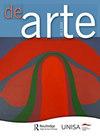Self/Other/Clay/Skin: Reflections on Ceramics by Andile Dyalvane, Juliet Armstrong, and Kim Bagley
IF 0.1
0 ART
引用次数: 0
Abstract
Abstract This reflection on practice develops the idea of a skin metaphor in the work of a selection of contemporary South African artists working in clay. In particular, it discusses selected works by Juliet Armstrong and Andile Dyalvane in relation to the author's own practice. The author proposes that body- and skin-like forms can speak about how we see ourselves and others within post-apartheid South African cultural contexts. Themes discussed in relation to ceramic works include cultural appropriation, the anxieties of whiteness, and cultural identities. The article covers works produced at least ten years after the pivotal democratic elections in 1994 that symbolise the end of the socially and economically damaging apartheid regime. With this in mind, all of these works can be interpreted as part of an (admittedly flawed) project of slowly healing our metaphorical skin, in which South African artists have grappled with cultural and human identities from a range of highly individual perspectives. In engaging with their works, we are better able to understand specific local human conditions.Andile Dyalvane、Juliet Armstrong和Kim Bagley的《自我/他人/粘土/皮肤:陶瓷反思》
摘要这种对实践的反思在当代南非粘土艺术家的作品中发展了皮肤隐喻的概念。特别是,结合作者自身的实践,对朱丽叶·阿姆斯特朗和安迪勒·达尔万的作品选集进行了探讨。作者提出,类似身体和皮肤的形式可以说明我们在后种族隔离的南非文化背景下如何看待自己和他人。与陶瓷作品相关的主题包括文化挪用、对白人的焦虑和文化身份。这篇文章涵盖了1994年关键的民主选举后至少十年创作的作品,这些作品象征着破坏社会和经济的种族隔离制度的结束。考虑到这一点,所有这些作品都可以被解释为一个缓慢治愈我们隐喻性皮肤的项目(诚然有缺陷)的一部分,在这个项目中,南非艺术家从一系列高度个人化的角度与文化和人类身份作斗争。通过参与他们的作品,我们能够更好地了解当地的具体人文条件。
本文章由计算机程序翻译,如有差异,请以英文原文为准。
求助全文
约1分钟内获得全文
求助全文

 求助内容:
求助内容: 应助结果提醒方式:
应助结果提醒方式:


